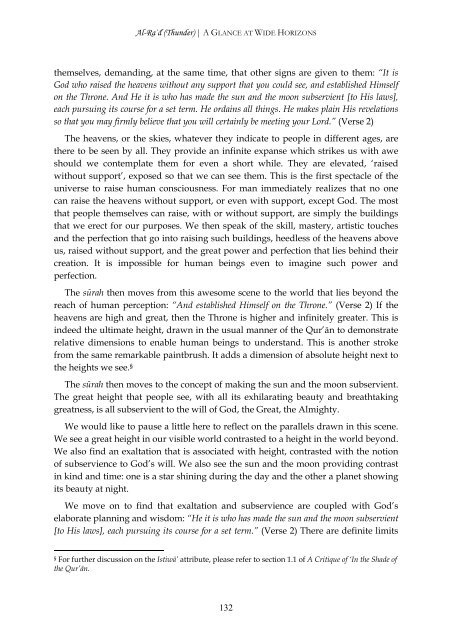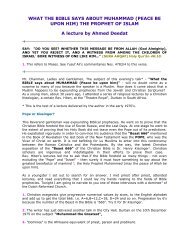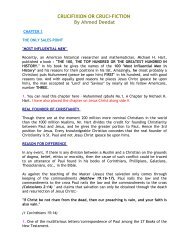Volume 10 Surah 12 - 15 - Enjoy Islam
Volume 10 Surah 12 - 15 - Enjoy Islam
Volume 10 Surah 12 - 15 - Enjoy Islam
You also want an ePaper? Increase the reach of your titles
YUMPU automatically turns print PDFs into web optimized ePapers that Google loves.
Al-Ra`đ (Thunder) | A GLANCE AT WIDE HORIZONS<br />
themselves, demanding, at the same time, that other signs are given to them: “It is<br />
God who raised the heavens without any support that you could see, and established Himself<br />
on the Throne. And He it is who has made the sun and the moon subservient [to His laws],<br />
each pursuing its course for a set term. He ordains all things. He makes plain His revelations<br />
so that you may firmly believe that you will certainly be meeting your Lord.” (Verse 2)<br />
The heavens, or the skies, whatever they indicate to people in different ages, are<br />
there to be seen by all. They provide an infinite expanse which strikes us with awe<br />
should we contemplate them for even a short while. They are elevated, ‘raised<br />
without support’, exposed so that we can see them. This is the first spectacle of the<br />
universe to raise human consciousness. For man immediately realizes that no one<br />
can raise the heavens without support, or even with support, except God. The most<br />
that people themselves can raise, with or without support, are simply the buildings<br />
that we erect for our purposes. We then speak of the skill, mastery, artistic touches<br />
and the perfection that go into raising such buildings, heedless of the heavens above<br />
us, raised without support, and the great power and perfection that lies behind their<br />
creation. It is impossible for human beings even to imagine such power and<br />
perfection.<br />
The sūrah then moves from this awesome scene to the world that lies beyond the<br />
reach of human perception: “And established Himself on the Throne.” (Verse 2) If the<br />
heavens are high and great, then the Throne is higher and infinitely greater. This is<br />
indeed the ultimate height, drawn in the usual manner of the Qur’ān to demonstrate<br />
relative dimensions to enable human beings to understand. This is another stroke<br />
from the same remarkable paintbrush. It adds a dimension of absolute height next to<br />
the heights we see. §<br />
The sūrah then moves to the concept of making the sun and the moon subservient.<br />
The great height that people see, with all its exhilarating beauty and breathtaking<br />
greatness, is all subservient to the will of God, the Great, the Almighty.<br />
We would like to pause a little here to reflect on the parallels drawn in this scene.<br />
We see a great height in our visible world contrasted to a height in the world beyond.<br />
We also find an exaltation that is associated with height, contrasted with the notion<br />
of subservience to God’s will. We also see the sun and the moon providing contrast<br />
in kind and time: one is a star shining during the day and the other a planet showing<br />
its beauty at night.<br />
We move on to find that exaltation and subservience are coupled with God’s<br />
elaborate planning and wisdom: “He it is who has made the sun and the moon subservient<br />
[to His laws], each pursuing its course for a set term.” (Verse 2) There are definite limits<br />
§ For further discussion on the Istiwā’ attribute, please refer to section 1.1 of A Critique of ‘In the Shade of<br />
the Qur’ān.<br />
132

















